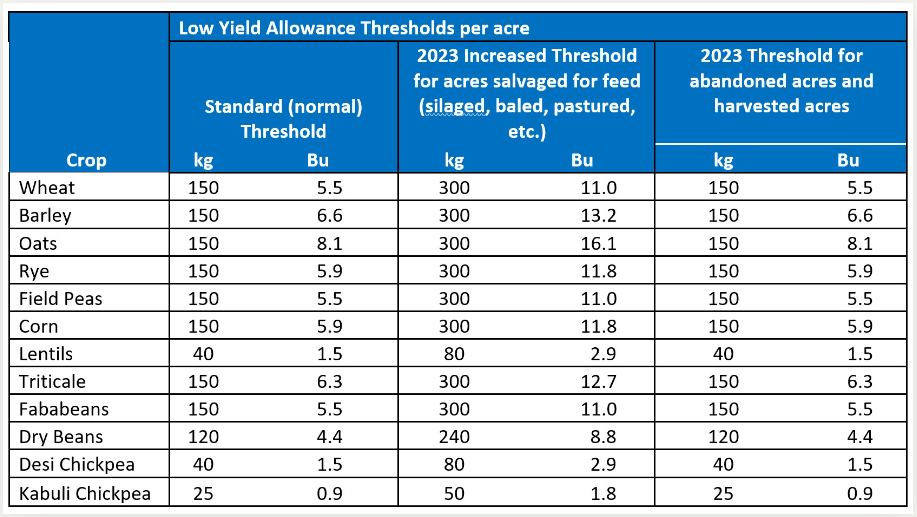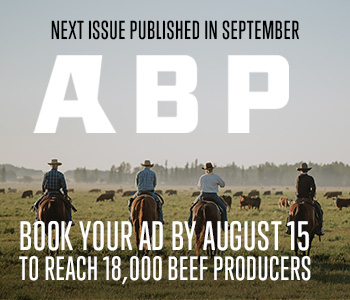AB Direct - Steers
Rail: 495.00-500.00 del
AB Direct - Heifers
Rail: 495.00-500.00 del
US Trade- Steers
Rail: ---
US Trade - Heifers
Rail: ---
Canadian Dollar
0.12
AFSC: Low yield allowance change encourages poor crops be used as feed
AFSC is adjusting the low yield allowance for 2023 to encourage farmers to put more poor-quality crops towards livestock feed.
For 2023, AFSC is doubling the low yield threshold to allow for additional cereal or pulse crops to be salvaged for livestock feed. For example, the barley crop threshold will be increased from 150 to 300 kg per acre. The low yield allowance is a standard part of production insurance and is meant for situations where there may not be value in harvesting for grain (e.g., low yield due to extreme heat and severe drought).
This adjustment enables producers to act swiftly to salvage crops for livestock feed rather than watch their fields deteriorate further, and risk harvesting nothing.
Low Yield Allowance changes
If the appraised yield falls below the established threshold level, AFSC can reduce the appraisal to zero based on information gathered by the adjuster during the inspection. The appraised yield of the crop is used in the calculation of any subsequent indemnities.
The threshold values are meant to reflect the approximate cost of harvesting when a crop is not worth harvesting.
- This can be applied on a per field basis. It does not have to be applied to the entire crop.
- Low yield allowances may be applied to a portion of a field.
- All eligible acres must be put to an alternate use (for feed).
Important to know: The preharvest process remains the same for clients
To help ensure a smoother process, clients should contact AFSC at least five days in advance of starting the work. They will need to provide the crop type, number of acres and estimated yield on the acres that will be put to an alternate use as well as the intended use (e.g. pasturing, silage)
AFSC will work with clients to complete the field inspection as soon as possible. If an adjuster is not able to inspect the field before work is scheduled to start, clients can, once authorized by AFSC, leave standing inspection strips or exclosures on the acres being put to an alternate use. AFSC will complete the inspection and determine a yield appraisal as soon as possible.
Low Yield Allowance Q&A
Changes have been made to low yield allowance for crops taken out of production for livestock feed. Examples are silaging, baling, and pasturing.

Q: My crop has already been inspected by AFSC and I’ve begun hay/silaging the crop. With the announcement of an increase in the low yield allowance threshold, do I need to do anything else?
No, you don’t have to do anything further. AFSC will track all previously appraised yield potentials. If the yield appraisal assessed on your acres now falls into the new low yield allowance, you will receive the same treatment/compensation regardless of when the claim was inspected.
Q: Why is the low yield allowance adjustment only applied to poor crops put to feed?
AFSC is changing the threshold values for the low yield allowance to help encourage farmers to salvage poor crops for feed, rather than abandoning the acres.
Q: Will the low yield allowance apply if I opt to combine my crop?
The low yield allowance applies to all harvested crops, based on the average of the whole crop, rather than on a spot-loss basis. Combined crops will continue to have the established low yield allowances apply.
The recent threshold adjustment only applies to crops put to another use as livestock feed.
Q: My crop is damaged to the point where there is nothing to salvage for feed. Does this adjustment impact me?
If the crop is worth less than the cost of harvesting it and you intend to abandon it, the adjustment will not apply. Your crop may fall into the standard low yield appraisal and count as zero yield.
Q: Why isn’t canola included in the changes to the low yield allowance?
As an oilseed, canola isn’t typically a crop put to another use for feed, although it may be in extreme circumstances. The existing low yield allowance remains in place for all oilseed crops and clients will be compensated for their losses when the total insured acres of the canola crop fall below coverage levels.
Q: Is this change for the 2023 crop year only?
This change is for the 2023 crop year only.
Putting poor crops to alternate use
Several areas in Alberta have experienced limited precipitation this growing season. As a result, some producers are considering putting their crops to alternate uses rather than waiting for them to mature and mechanically harvesting them.
AFSC clients with production insurance can choose to use their insured crop for alternate use including pasturing, ploughing down, spraying out, silaging or harvesting the crop into an immeasurable state.
At least five days in advance of putting an insured crop to an alternate use, clients need to contact AFSC and arrange for a yield appraisal and the release of the insured acres. Putting an insured crop to an alternate use before the acres are released by AFSC may impact the adjusted production in determining potential claims and future coverage.
When contacting AFSC, clients will need to provide the number of acres intended to be put to an alternate use and an estimate of the yield. Depending on the estimate of yield, the acres may be released from an AFSC branch office, or an adjuster may complete a field inspection to determine the yield appraisal before acres are released.
Clients wanting to put an insured crop to an alternate use before the acres are released can leave standing inspection strips or exclosures with prior approval by AFSC. Annual crops may be left in the swath as well to allow AFSC to conduct a yield appraisal.
Clients should review the information on Inspection Strips to ensure they understand what is required and avoid any potential negative impacts to their insurance.
Questions
Please use live chat on our website or AFSC Connect, call our Client Care Centre at 1.877.899.2372 or contact your preferred branch office for additional information.

